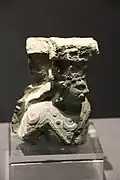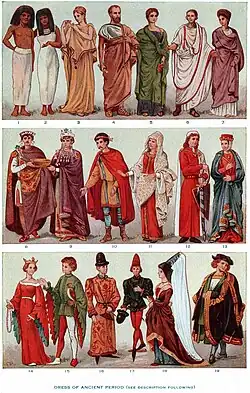Chamail (clothing)


The chamail is a type of poncho-like clothing from Central Asia.[2]
As a result of Central-Asian influence, this type of clothing also appears in Indian works of art of the 1st millennium CE, as in Ajanta or Bagh.[2] The chamail was probably introduced in India by the Sakas or the Kushans.[2] The chamail also appears in Gandharan Buddhist sites such as Fondukistan and Bamiyan, and even as far as Xinjiang.[2] In Kashmir also, the chamail appears on the Buddha or Bodhisattavas during the 6–7th century CE.[2]
Examples
-
 Gandhara King devotee wearing the chamail, 3rd–4th century CE
Gandhara King devotee wearing the chamail, 3rd–4th century CE -
![A foreigner in Sasanian dress drinking wine, on the ceiling of the central hall of Cave 1, Ajanta, likely a generic scene from an object imported from Central Asia (460–480 CE)[3][4]](./_assets_/Ajanta_Cave_1_ceiling_foreign_dignitary.jpg)
-
![Wearer of a chamail (right) in the Penjikent murals[2]](./_assets_/Penjikent._Faramarz_and_the_Princess_of_Kahila%252C_before_King_Key_Khosrow_and_Rostam.jpg) Wearer of a chamail (right) in the Penjikent murals[2]
Wearer of a chamail (right) in the Penjikent murals[2] -
 Servant wearing chamail dress, Penjikent
Servant wearing chamail dress, Penjikent
References
- ^ Compareti, Matteo (2009). "Iranian Elements in Kaśmīr and Tibet Sasanian and Sogdian Borrowings in Kashmiri and Tibetan Art". Transoxiana. 14.
- ^ a b c d e f Compareti, Matteo (2014). "Some Examples of Central Asian Decorative Elements in Ajanta and Bagh Indian Paintings". The Silk Road. 12: 40–41.
- ^ Brancaccio, Pia (2010). The Buddhist Caves at Aurangabad: Transformations in Art and Religion. BRILL. pp. 80–82, 305–307 with footnotes. ISBN 978-9004185258.
- ^ DK Eyewitness Travel Guide India. Dorling Kindersley Limited. 2017. p. 126. ISBN 9780241326244.
Sources
- Spink, Walter M. (2007). Ajanta: History and Development, Volume 5: Cave by Cave. Leiden: Brill. ISBN 978-90-04-15644-9.
